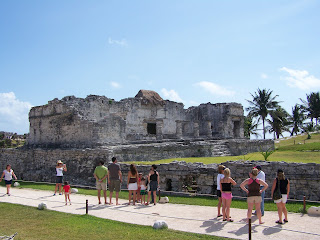The movie on Wednesday introduced us to the Africa's great ruin, Great Zimbabwe. You can learn a great amount of information through the previous post on our blog, but I am going to introduce you to some of the Europeans ideas on the religion that occupied the land. Their thoughts included the idea that the area might be the capital of the Queen of Sheba or possibly the Christian King, Prester John. Africa and its cities are not completely understood and the ideas of whom, when, and where it began are not positively correct, but we will now take a look at these two different religious figures and you can decide which one you believe to be correct.
http://theculturedtraveler.com/Heritage/Archives/Zimbabwe.htm
Queen of Sheba
http://www.epilogue.net/cgi/database/art/view.pl?id=104085
She is a woman of royalty and also a biblical figure who was born in the 10th century B.C. She was born in Sheba which is today's Yeoman, or Ethiopia. She is now known in the Bible as the wealthy queen who tested King Soloman. It is believed that after her experience with the King, she traveled back to Sheba and bore a child to King Soloman, Menelik I, which is, according to the Ethiopian tradition, the beginning of the Ethiopian royal dynasty.
This story is a remarkable one, in which the Queen was invited to a banquet that King Soloman was deliberately giving her extremely spicy foods to induce her thirst. At the end of the night she made the King promise that he would not take her by force and, in turn, he made her promise that she would not steal anything from his home. When she awoke in the middle of the night with a need to quench her thirst she took from a jar of water, not understanding that this would be considered stealing. With this honest mistake King Soloman and the Queen of Sheba spent the night together.
The tradition that the Biblical Queen of Sheba was a ruler of Ethiopia who visited King Solomon in Jerusalem, in ancient Israel, is supported by the first century C.E. Roman (of Jewish origin) historian Flavius Josephus, who identified Solomon’s visitor as a "Queen of Egypt and Ethiopia".
http://www.answers.com/topic/queen-of-sheba#Possible_Egyptian_derivation
Prester John
http://www.home.earthlink.net/.../soldiers/scenario8.html
His name was given to him as a mythical medieval Christian priest-king of a large empire in Central Asia and Ethiopia.
It was during the Fifth Crusade that information on Ethiopia was being gathered by the Crusaders. It was then that the Christian sovereigns of Ethiopia, who were constantly found fighting to defend their religion, became known in Europe. It was Jourdain Catalani who described "the sovereign of Christian Ethiopia as Prester John". After this conclusion was made and more data was found, Prester John's kingdom was believed to be located in Africa and his legend became much more fascinating while his popularity grew.
Prester John was believed to have the power of cutting off the flow of the Nile towards Egypt (an ancient Ethiopian tradition). Again, it was said that, in Prester John's country, children were baptized with fire and not with water.
http://www.dacb.org/stories/ethiopia/prester_john.html
Now that you have a little bit of information about how the Europeans may have formed their opinions on certain areas of Africa, you can form your own.







